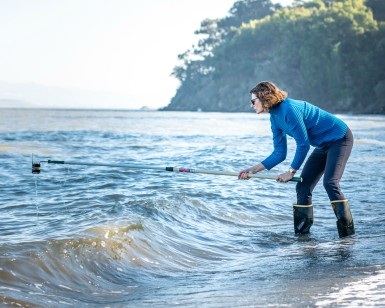San Rafael, CA – Water quality was good to excellent last summer at all Marin County beaches according to a new report from Heal The Bay, which annually rates water quality at beaches along the U.S. West Coast.
 Lorene Jackson of the County's Environmental Health Division scoops water out of San Francisco Bay for testing at China Camp State Beach.
Lorene Jackson of the County's Environmental Health Division scoops water out of San Francisco Bay for testing at China Camp State Beach. Eight beach locations received A-plus scores, 14 were rated A and two earned B’s during the April-through-October monitoring season. The grades came from sampling 28 sites over 31 weeks.
It wasn’t as glowing during the wet weather checks. Although 17 Marin spots received A-pluses, five locations received F’s. However, the wet weather grades are based on the limited number of rain days that may occur during the April-through-October testing period. If there is one rain day and a site exceeds the pollution limit that day, it may get an F grade.
Marin’s water quality monitoring program, overseen by the Marin County Community Development Agency’s Environmental Health Services Division (EHS), gathered data from April 2018 through November 2018 from 23 bayside and oceanside monitoring locations. The Marin locations tested regularly are Stinson Beach, Muir Beach, Bolinas Beach, Baker Beach, Rodeo Beach, Schoonmaker Beach, McNears Beach, China Camp State Park, and seven beaches on Tomales Bay.
Summer dry grades were excellent across the state but lower than average, with 94% of California beaches receiving A and B grades. Winter dry grades were good but below average, with 87% receiving A and B grades. The Heal the Bay report cites higher rainfall totals than the previous year as a likely culprit for more low grades.
Rain alleviates drought conditions, but more rain means that more pollutants, including bacteria, are being flushed into the ocean. Rain flushes contaminants from streets, including trash, fertilizer, pet waste, metals, and automotive fluids, into urban waterways. The untreated runoff drains directly into the ocean and results in elevated bacteria levels. Additionally, seasonal high groundwater tables may result in septic seepage reaching waterways.
According to the report, Marin experienced 41 sewage spills that reached a body of water in the 2018-19 monitoring period, up from 17 in 2017-18. That figure is about double the average for the 17 coastal counties (Los Angeles County had a high of 96 spills). The Marin spills amounted to 247,861 gallons of sewage reaching surface water.
Heal the Bay, based in Santa Monica, has analyzed water quality data at California beaches each year since 1991. It also rates beaches in Oregon and Washington. The Beach Report Card is funded by grants from the Surf Industry Manufacturers Association and the Grousbeck Family Foundation. See the full report at HealtheBay.org.
Marin EHS has monitored ocean, bay and freshwater sites since 2003 and posts sample results weekly. The samples are processed by the Napa-Solano-Yolo-Marin County Public Health Lab. The tests utilized, quantify the most-probable number of Total Coliform, E. coli, and Enterococcus bacteria present in each water sample.
While Heal the Bay looks at marine samples only, the County also tests several freshwater sites on Lagunitas and San Geronimo Creeks. In the 2018-19 season, those sites would receive poor grades. Bacteria exceeded recreational standards at the Inkwells in Lagunitas (75% of the time), Green Bridge near Point Reyes Station (52%), and Samuel P. Taylor State Park (41%).
If lab results indicate water samples exceed State of California standards for recreational waters, a warning sign is posted to alert the public that bacterial standards were not met. The California Department of Public Health advises beach users to avoid contact with recreational waters where warning signs are posted. People in contact with elevated bacteria levels in recreational waters may become ill.
Heal the Bay recommends beach users never swim within 100 yards on either side of a flowing storm drain, creek, or river in any coastal waters during a rainstorm. People should stay out of the water for at least three days after a storm has ended.
Learn more about the testing program on the webpage.